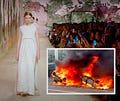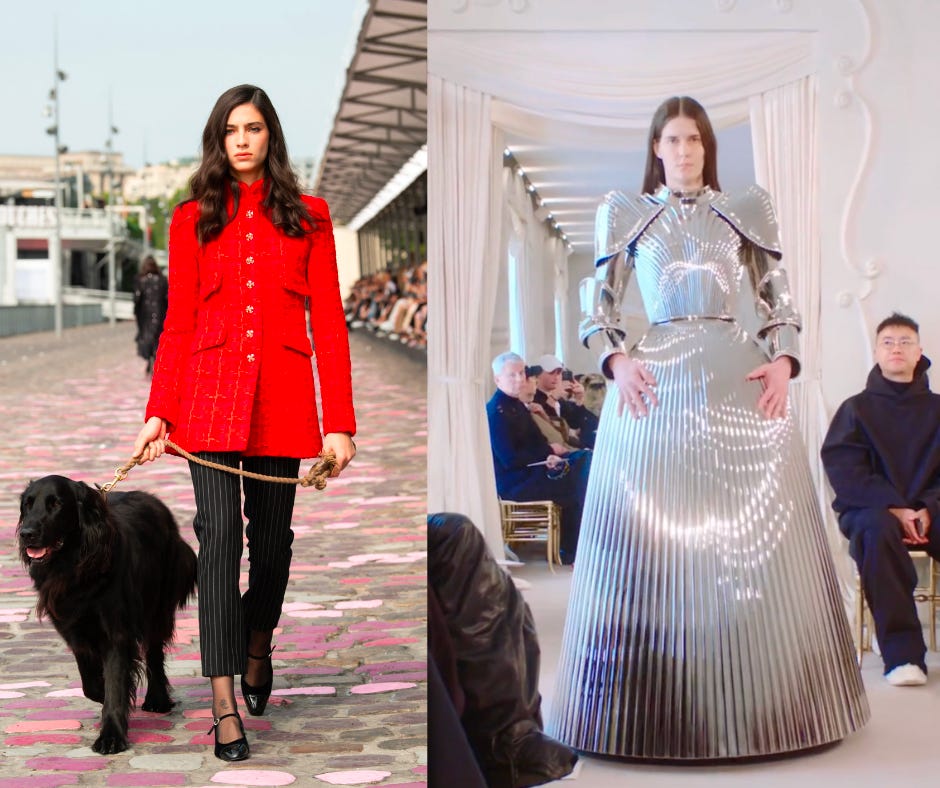An Uncomfortable Couture Week During French Protests
Should brands have canceled? Plus, what you need to know about the shows.
Couture: A Note on the Protests
An increasingly apparent inconvenient truth for the fashion industry is that major shows will be scheduled during times of civil unrest, war, or political turmoil that captivates Western nations. Such has been the case with the couture shows that just wrapped in Paris, where violent protests have raged for days following the police killing of Nahel Merzouk, a 17-year-old French citizen of Algerian-Morroccan descent, in the working-class Paris suburb of Nanterre during a traffic stop. For many, the youth-led protests will harken those that took place in the U.S. following the police killings of George Floyd and Breonna Taylor in 2020.
The New York Times reported Tuesday:
After five nights of fury over Mr. Merzouk’s killing, the country has calmed down and begun to assess the damage: more than 5,000 vehicles burned, 1,000 buildings damaged or looted, 250 police stations or gendarmeries attacked, more than 700 officers injured.
Some 3,400 people were arrested as a massive police presence set out to restore order.
The Guardian’s Jess Cartner-Morley wrote that Paris couture shows “proceeding untroubled by turbulence in less affluent areas of the city is perhaps a reflection of the polarisation that underpins the situation in France.” We saw this polarization in the spring when demonstrations against raising the legal retirement age from 62 to 64 targeted Dior parent company LVMH, with protesters proclaiming that money for the pension fund could come from billionaire LVMH chief Bernard Arnault.
In recent years, we’ve seen fashion brands struggle with increasing frequency to figure out what to do during extraordinary circumstances. The industry remains without unified response. When Russia invaded Ukraine, Giorgio Armani staged his planned fashion show without music while Balenciaga’s Demna turned his show into a tribute to refugees, stating, “Fashion doesn’t matter now.”
Earlier in Back Row: Russia Invades Ukraine, Fashion Week Carries On
But this time, the protests were barely acknowledged in Fashion Land. As has become routine when fashion and socio-political issues collide, the media and general public have taken to blaming influencers, who have become a punching bag for the industry’s ills. They’re probably seen as a safe target because many consumers find them annoying (let’s be honest: everyone who is online a lot is to some degree annoying). Plus, media brands don’t have to worry about them pulling ad dollars the way a brand could. Rolling Stone wrote up influencer Masoom Minawala Mehta, who said she “decided to go [to couture] because frankly it’s an important season for me,” only to later be called “entitled” and “privileged.”
But blaming influencers for the tone-deafness of couture week during social justice protests seems misguided. Influencers take their cues from brands, so if brands decide to have fashion shows, influencers will go because their businesses depend on being there. If brands cancel their shows, influencers will not go and might explain to their followers why they’re not going. But influencers are not making decisions about whether or not the shows should occur.
The decision a brand must make is whether or not to absorb the costs associated with canceling or delaying a fashion show in order to be sensitive to a situation, or proceeding as usual knowing that that course of action might upset consumers (and while most consumers don’t buy couture, the shows are a marketing vehicle for the brand in general, including the bags, makeup, and fragrances that are purchased much more widely). Absorbing the costs of cancellation or postponement will of course be easier for some brands than others. You could argue it’s unfair to place this decision squarely on the shoulders of brands and that the Fédération de la Haute Couture et de la Mode, which governs all things couture, should have stepped in and tried to help figure out a collective course of action.
That body might want to touch base with members and do some soul-searching, because violent world events will continue unfolding during fashion weeks, and consumers are going to continue to look to the industry and brands to respond in an appropriate way. This is why canceling or postponing shows may very well be a better course of action than continuing. Even if people at brands are morally unbothered by the idea of luxury fashion staging its major events while social justice protests rage nearby, many consumers will disagree, and that can be bad for business. We have recent evidence of public outrage affecting a brand’s earnings: a report from HSBC cited the fallout from Balenciaga’s controversial holiday campaign featuring children for a dismal fourth quarter for parent company Kering. Whether or not you thought the outrage was justified, the existence of the outrage still mattered.
Hedi Slimane was the only designer to cancel a major show for Celine menswear during the protests. He said on Instagram, “Having a fashion show in Paris, while France and its capital are bereaved and bruised, from my point of view alone, seems inconsiderate and totally out of place.” (Several outlets noted that the show was going to be a celebration of youth culture.) Chloe also canceled an event honoring Karl Lagerfeld, which seemed wise especially because, frankly, the man has been honored enough this year.
Couture: The Back Row Runway Roundup
Since the shows did occur and many of us want to keep up with them, here is Back Row’s roundup of things that happened.
A single dog appeared on the Chanel runway, which I’ve seen described in a number of social media posts as the cutest thing from the collection. Vogue.com explained the show was supposed to be an expression of French women just casually strolling around: “Sans high-flown concepts, jokes, or theatrical gimmicks, her focus is on capturing the essence of Frenchness.” A low point was the striped pants; a high point was the opening midi-skirt/coat combo.
Balenciaga returned to couture with a soundtrack of opera music and the expected sculptural tailoring and evening wear. Many fashion shows these days seem to be met with obligatory breathlessness on social media, and this one was no exception, much of the breathlessness being directed toward the final look, a metal-looking dress reminiscent of medieval armor. It was actually 3D-printed, chrome-painted resin.
Potentially controversial opinion:
Keep reading with a 7-day free trial
Subscribe to Back Row to keep reading this post and get 7 days of free access to the full post archives.




